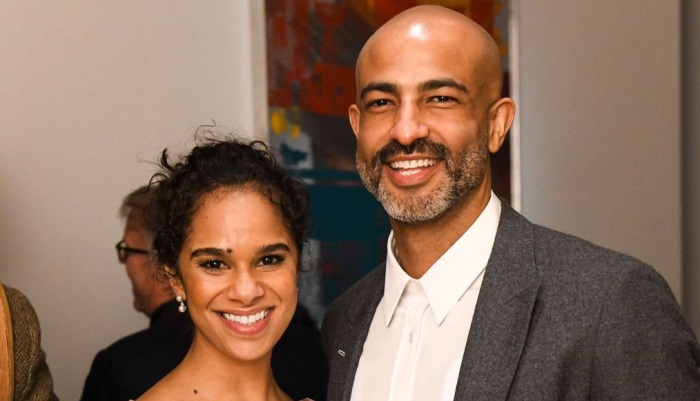Misty Copeland is a ballet dancer under ABT – the American Ballet Theatre.
She is famous for being a true prodigy, an exceptional performer, and the first African half-blood who reached the Principal rank in ABT after the company’s long history.
Today, we take a deeper look into Copeland’s background and career!
Table of Contents
Misty Copeland’s Family
Misty Copeland was born to a German-African-American father and an Italian-African-American mother in Kansas, Missouri.
Due to the numerous marriages that her mother, DelaCerna, had been through, she has three older siblings and two younger half-siblings.
Copeland didn’t see her biological father again until she was 22. As she regretted not doing so sooner, he might have been a good man in her opinion.
Misty Copeland & husband, Olu Evans, met during her early years with ABT when she was going through hardships.
According to her, he was one of the biggest reasons that made her feel confident with her curvy body again. They got married in 2016 and have one child together.
Copeland’s mother used to be a cheerleader while her older sister Erica was the leader of her secondary school’s drill team, though neither of them ventured into the world of arts and showbiz.
Copeland’s husband isn’t a celebrity, either.
Misty Copeland’s Height
When Copeland first joined ABT, she was like any other ballerina we might picture: petite and slim. The young Copeland stood at 5 ft 2 inches (about 157 cm) and weighed 108 pounds (about 49 kg).
For improvement of her bones, Copeland followed professional instructions and gained 10 pounds. Hence, she ended up weighing about 54 kg before adjusting it to 51 – 52 kg for a balance of health and measurement.
Misty Copeland’s Net Worth
Most calculators estimate Copeland’s net worth to be approximately $1.5 million, which is suitable for a highly acclaimed principal ballerina of our time.
While the amount she earned from her salary as a dancer certainly is impressive, we should also take into account the avenues this talented woman has accomplishments in:
- Appearances: The influence of Copeland spreads beyond ballet, which means her appearances on TV shows, endorsements, commercials, and images are extremely valuable.
- Business: Not afraid to try new things, Copeland has launched a brand called M by Misty.
- Writing: Not only is writing an outlet of emotions for Copeland, but her published books have certainly contributed to her net worth.
Misty Copeland’s Early Life & Education
Early Life
When Copeland moved to San Pedro, Los Angeles with her new family, they were financially unstable.
This might explain why she didn’t have any access to ballet until 13 years old despite having grown a fondness for gymnastics and ballet since she was seven.
Before learning to dance professionally, Copeland already enjoyed creating her moves and flips with Mariah Carey’s songs in the background. This hobby convinced her to join the competitive dance team in her middle school.
While Copeland was certainly talented, it must have been fate that the team’s coach was also a classical dancer and immediately noticed her flair.
Check more: Svetlana Zakharova: Biography, Husband, Net Worth & More
Dance Education
In 1996, the coach Elizabeth Cantine strongly recommended Copeland to a local club for ballet training because there was a free course by Cynthia Bradley, and her mother didn’t disapprove.
Impressed by Copeland’s talents, Bradley tried to recruit Copeland for her humble ballet school, yet Copeland declined the offer because she wasn’t in the best situation for it.
Both her mom and her older sister were working hard with no time or resources to afford extra dance classes.
It was only when Bradley started giving her rides from school and back home did Copeland start attending classes.
As Copeland was able to achieve en pointe after only three months, Bradley was very insistent on helping her pursue ballet even when DelaCerna wanted her to give up.
With a life story and management contract, the Bradleys welcomed Misty Copeland into their family during weekdays and returned to her home for weekends.
Roughly a year later, Copeland won a national contest in ballet and also the first solo role in her life.
Bradley’s husband was a teacher of modern dance, and he also served as Copeland’s instructor & partner for pas de deux. From 15 years old onwards, Copeland was homeschooled to have even more time for dancing.
In 1998, Copeland got offers from ABT, Joffrey Ballet, Dance Theater of Harlem, and San Francisco Ballet School for their workshops.
She and Bradley chose San Francisco Ballet and received full-time student offers from them after the six-week program. She declined due to her mother asking her to come home, which opened up a new page in her life.
Custody Battle
Copeland didn’t expect DelaCerna to resent Bradley’s influence on her, to the point of demanding a stop with the Bradleys. They argued over this matter almost every day, and Copeland was so scared of not being able to dance again.
With the help of the Bradleys, she was familiarized with the concept of emancipation and went to stay with a friend while the lawyer filed the necessary papers.
DelaCerna brought her home by reporting her missing to the police and went for restraining orders against the Bradleys, which wasn’t considered legal because the Bradleys didn’t harass or stalk them.
After many claims and accusations that cost the press so much paper and ink, both the emancipation and the restraining orders were canceled when DelaCerna vowed she wouldn’t take dancing away from Copeland and stated once again that she wouldn’t change her mind about getting the Bradleys out of Copeland’s life.
In the same year, all parties took part in the Leeza talk show and “bickered shamelessly” while Copeland remained silent, indicating that the relationship between them didn’t and probably won’t ever become better.
Misty Copeland’s Dancing Career
Early Success
By the age of fourteen, Copeland started coming to the attention of the media because she was getting approximately 2,000 viewers with each show for Bradley’s San Pedro Dance Center, and this number was earned only 8 months after she attended school.
Fifteen, she continued to amaze with the Los Angeles Music Center Spotlight Awards, Winner of the Gifted High-School Students in South California, and, most impressively, the Best Young Dancers by the Los Angeles Times.
The beginning with ABT
The long-term bond between Copeland and ABT began in 1999, a year after the custody battle, when she joined their Summer Intensive program and got invited to work for them.
Nonetheless, DelaCerna wanted her daughter to complete high school first, even as ABT offered to cover housing accommodations, academic arrangements, and performance payments.
Therefore, Copeland returned to ABT’s summer program in 2000 and was selected for the junior troupe and the Studio Company, a second branch of ABT.

Another significant change occurred in her life when she suffered a fracture and the doctor suggested she induce puberty so her bones would become stronger. This process added 10 pounds to her weight.
Ballerinas are traditionally very thin and delicate, which put immense pressure on the young lady and made her struggle to focus on dancing until friendships outside of ballet helped her out of the depressing abyss.
She embraced her curves, and her movements became stronger than before.
Another burden she went through in this phase was being the only black dancer in ABT and consequently feeling indecisive about career choices. The higher-ups at ABT cared deeply about Copeland and introduced her to black trailblazers for a better perspective.
Even at the beginning of her career, significant reviewers described her with the most generous praises, from saying she was one of the most radiant stars on the stage regardless of her age to calling her performance an illusion of perfect smoothness.
Soloist
7 years after joining ABT’s second company, Copeland became one of the youngest soloists in the company’s history.
She wasn’t the first black female ballerina soloist ABT had promoted, though she was the only one during her time with ABT. The skin color made her stand out and simultaneously suffer from cultural isolation.
Being a soloist gave her more opportunities to participate in bigger plays with significant roles, in which she shone rather than drowned in pressure. Even after a stress fracture, her performances were still highly appreciated.
From modern ballets, Copeland eventually achieved full-length repertory pieces, and the depth of her artistry was widely acknowledged. She was exuberant, ingratiating, and sublime – quoted from the most important media sources in ballet art.
The first half of 2015 witnessed a series of successful roles for Misty Copeland, especially as Odette/Odile in Black Swan. Macauley of The New York Times called it the most epic performance, while Vanity Fair and The Wall Street Journal referred to it as a crown in her career.
Also, in this Swan Lake ballet, pioneers Lauren Anderson and Raven Wilkinson came onto the stage and gave Copeland congratulatory bouquets. Ballet enthusiasts all viewed this event as the forthcoming promotion for Copeland.
Principal Dancer
In June 2015, ABT surprised the entire ballet industry with its decision to promote Misty Copeland to the Principal Dancer position.
Although her talent was widely acclaimed, the 75-year history of ABT simply has never witnessed an African-American dancer claiming such a role.
This achievement would only become more impressive if you knew there had never been a black woman promoted to be the principal dancer in a dance company at an international level.
Following the promotion, Misty Copeland took the lead role in the Broadway adaptation of On The Town, which was played for two successive weeks. It also marked Copeland’s Broadway debut and received pleasant reviews from renowned names in the media.
The rest of the year was busier than ever for Copeland, although no project beats the role of Clara in ABT’s Nutcracker.
Afterward, she continuously earned lead roles in various ABT productions like Sleeping Beauty, La Fille Mal Gardee, Romeo & Juliet, and Swan Lake to name a few.
Misty Copeland Awards & Accomplishments
As a prodigy who shone despite the very late start compared to most ballerinas and the most inspiring black female dancer in the art of ballet, Misty Copeland was invited to TV shows and films with all due respect.
Some of her most well-known appearances are:
- So You Think You Can Dance (S11, 2014)
- Life in Motion (adapted from her memoir, 2014)
- A Ballerina’s Tale (documentary film, 2015)
- Interview with Barack Obama (2016)
- World of Dance (2017)
- The Nutcracker and the Four Realms (2018)
Alongside the achievements, Copeland’s career was further decorated with honorable awards:
- Leonore Annenberg Fellowship in Arts (2008)
- National Youth of the Year Ambassador (2013)
- Honorary Doctorate from the University of Hartford (2014)
- Dance Magazine Awards Honoree (2014)
- Glamour’s Women of the Year (2015)
- ESPN’s 2015 Impact 25 (2015)
- Spingarn Medal by NAACP (2021)
- Honorary Doctor of Fine Arts by New York University (2023)
Misty Copeland’s Books
Longtime fans of Misty Copeland know writing is her second passion. Since 2014, she has had 7 books published with positive feedback.
Her memoir was a bestseller for the New York Times with Life in Motion: An Unlikely Ballerina (2014).
She also wrote two books for children, Firebird and Bunheads, which won various awards. The attempt with the fitness & health book was highly appreciated as well.
What Is Misty Copeland Doing Now?
People who have learned all about Misty Copeland are likely to admire the talent and energy she always shares with the world around her. Now at the age of her forties, she is still active in various creative fields.
She isn’t afraid of pursuing a new career beyond ballet and dance, though her goals are with the younger generations, whether the children want to be on stage or contribute behind the scenes.



